Porcelain Insulator News
by Jack H. Tod
Reprinted from "INSULATORS - Crown Jewels of the Wire", September 1974, page 14
Preferably direct porcelain news items and questions directly to Jack H. Tod,
3427 N. 47th Place, Phoenix, Ariz. 85018. All mail will be answered if reply
stamp is enclosed, and the most newsworthy items and questions of general
interest will be published as space permits.
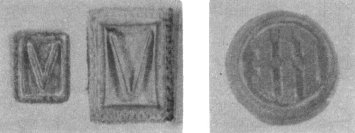
The photo above left shows (end view) two marking devices used to mark pin
type insulators by Victor Insulators, Inc., Victor, N.Y. (1935-1953). The
smaller marker is a metal handstamp for making incuse markings, and the larger
one is a rubber handstamp for underglaze markings. The marker in the right-hand
photo above was used for underglaze markings by I-T-E Imperial Corp., Victor,
N.Y. (1953-current), the successor to Victor Insulators, Inc.
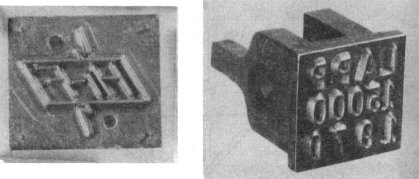
Both the metal marking devices in the above two photos were used by Lapp
Insulators Division, Interpace Corp. to make incuse markings. The one on the
left was for markings on line post insulators, and the one on the right was for
automatic marking of suspension disks. The 15000 refers to the insulator's
strength rating in pounds. This marking device has some significance since it
was used to mark the last run of suspensions at LeRoy, N.Y. before Lapp moved
all suspension insulator manufacture to their Sandersville, Ga. plant.
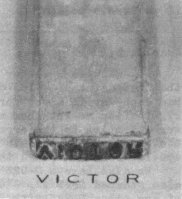
The marking device at the right has a hard rubber plate mounted on a wooden
slab and was used to apply the income "VICTOR" marking used by Locke
Insulator Mfg Co. Victor, N.Y. (1898-1910). An inkpad impression on the white
sheet in the photo shows the actual impression made by the stamp on the
insulators.
None of the marking stamp photos here are reproduced to actual size
necessarily.
Dear Jack:
A few days ago, I ran across a box of miscellaneous electrical stuff in a
junk shop. The box contained mostly cleats tubes and split knobs, but there were
also some "odds and ends" items in it.

One was a composition radio strain insulator as sketched here and with two
trademarks. One is Circle-JP, and the other is GESTONE, I think. The first
letter is hard to make out, but G is the most likely. You may be aware of this
marking, but it is new to me. Any ideas?
Bob Stewart,
Cincinnati
- - - - - - - - - -
Dear Bob:
This is a cute radio strain, and I think the Circle-JP marking is that of
Johns-Pratt Co., Hartford, Conn. Without going into detail on their history
(since 1854), the names involved were H. W. Johns Co., Johns-Pratt Co. (after
1886), H. W. Johns-Manville Co., and Johns-Manville Co. (currently). Due to
corporate structure and different plants and products, more than one of these
names were in use concurrently.
As you probably know, J-P made composition insulators, and there were some
patents by them for insulators just as you have. I don't have any listing on the
"GESTONE" tradename. It was probably a defunct one before the date of
the earliest directories I have, and I have not completed my tradename survey in
the Gazettes for that period. Walt Lehnert (Minneapolis) not only has the
largest collection of radio insulators that I know of, but he has also done
considerable research on all these markings for a long time. I consider him the
best authority on these, and he could probably confirm if this is a Johns-Pratt
tradename if you wrote to him.
Jack
Dear Jack:
... Back in December we got some Imperials from a man that had dates of 4-16,
4-17, 4-18, 4-19 and 4-20-1900. He had each day in a row for a week. Elton was
over one day right after we got them and was looking at them. He called our
attention to the error spelling in "Porcelain". All 5 of them had
"Porcelain" spelled wrong. All but one was spelled PORCELIAN, and the
other is spelled PORCELINN!
We also have a U-925 which has the VICTOR stamp and also stamped SEPT 12,
9101 instead of 1901. Have you heard of any other U-925 with this error?
Ed & Judy Gish,
Houston
- - - - - - - - -
Dear Ed & Judy:
Wow! This new PORCELINN error on Imperials must set some sort of a record for
illiteracy on the part of their stamp maker. Note from Bernard Warren's letter
this issue that they also had the PORCELAIN stamp in use 4-18-00, so that's at
least three stamps in use at that time. I hadn't heard of the PORCELINN error
until you reported it.
I recall having heard of the 9101 error on the Locke insulator but can't
remember who had it. Maybe you mentioned it to me in a letter last year.
(Ed & Judy didn't say which Imperial stamp had the PORCELINN error, but I
presume it is marking number (3) with the crown trademark. If otherwise, I'll
report it in a later issue.)

Dear Jack:
... today a fellow gave me a P.R.R which has a different incuse marking than
the ones I have or as listed in your book (Supplement B). It is much smaller and
is very noticeable when you pick it up (drawn actual size above). I've seen
dozens of these P.R.R.'s, but this is the first with the smaller marking I've
seen. I don't think it's real important, but I wondered if you've ever seen one
like it.
Ed Allander,
Duncannon, Pa.
- - - - - - - - -
Dear Ed:
Yes, it is important since we try to keep our listings of pin type markings
as complete as possible. I don't recall having seen one before, and even the
regular P.R.R. marking already listed is a fairly scarce one.
Jack
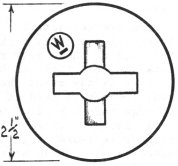
Dear Jack:
I found a mine-type insulator which has the Westinghouse trade mark
recess-embossed on it. This is similar to the O-B "Security Type" mine
insulators.
At an old dump site here most probably associated with Davidson Porcelain
Co., I also found several more new markings on dry process items.
First, a socket with BRYANT and also B. E. CO., so that attributes B. E. CO.
(Note. We held off on that because of the possibility of Best Electric Co., but
now agree Bryant Electric Co. JT)
Also found a sockett with ARROW as listed in Oct. 1972 Crown Jewels, but also
bearing their trademark as shown here.

I also found a 3-hole conduit end outlet bushing with an embossed marking J.
H. P. & S. on it, and do you know who used these initials?
At the old Trenle Porcelain plant site, I found a sockett marked T.T.P. CO.,
plus a catalog number. Can you decode the extra T in this?
Carl Lencse
East Liverpool, Ohio
- - - - - - - - -
Dear Carl:
Your Whse mine insulator is a nice find. These were made for them by an East
Liverpool electrical porcelain company, but I'd never seen the Whse marking on
one.
The J. H. P. & S. marking is for J. H. Parker & Son, a large
electrical jobber located for many years in Parkersburg, W. Va. and also later
in Chelsea, Mass. See page 177 of my book for details.
The T.T.P. CO. fits since the full name of the company was The Trenle
Porcelain Company.
Jack

Dear Jack:
Here is a rough sketch of a device that I picked up at a bottle show. I have
never seen another like it. It is brown porcelain with no marking (porcelain
2-1/2" x 5", 9-1/4" overall length).
It has a tapered copper automatic wire grip cemented into each end and is
evidently a circuit breaker. The copper wire grips are stamped FARGO 4 SOL #6
STR which is a common item, but I have never seen them used this way before.
Philip C. Palmer,
Seattle
- - - - - - - - -
Dear Philip:
You are correct. The gadget you have is used as a break for circuits such as
series-connected street lights. The advantage of these over regular break knobs
(strain insulators) is that they can be quickly installed in existing circuits
at any point where a break is required. In our area, these were used at one time
but no longer are -- although they may still be catalog items.
I have a specimen from our area, and the porcelain cylinder in 1-3/4"
diameter by 3" long, Fargo clamps being leaded into "sanded"
holes in each end. I presume the size of the porcelain part relates to the
voltage rating.
Jack
NEW PORCELAIN MARKING

Since the beginning of this year, McGraw-Edison Co.,
Macomb, Ill. has been using the underglaze marking shown at the right on all
"sky glaze" (Munsell) pin types. A specimen I received has blue ink
for the marking. They continue to use the other sandblast marking on all pin
types with brown glaze.
I suspect they continue to use the sandblast marking on the brown units to
maintain marking legibility. Most other companies using underglaze markings in
the past have solved this problem merely by use of a light colored ink on the
brown units, and I pointed this out to McGraw-Edison. This naturally simplifies
things on the production line. If they decided to adopt that procedure, this
would bring an end to the only remaining use of sandblast markings on the
unipart pin types.
... Before closing, I must congratulate you on your book. When I got mine I
sat down and read it all the way through, cover to cover. It was fascinating!
Why can't someone write such an interesting book on glass? Many glass insulator
books are interesting, but really aren't complete.
Paul Greaves,
Carmichael, Cal.
- - - - - - - - -
Dear Paul:
Thanks for your compliment on my book, but your analogy is incomplete. I
think the several better glass insulator books are very complete and accurate in
the aggregate. My books are fairly complete on unipart pin types, but it would
take about 2 more volumes like those to cover all the other porcelain insulator
field of interest to collectors.
I continually recommend that collectors buy all the better books on their
hobby, and the cost of getting even all of them is small in comparison with
money spent on the specimens and traveling to shows, etc. Each book adds to
your overall knowledge and enjoyment.
Jack
In the article about surface wiring insulators (nail knobs and cleats) in
this column about a year ago, I mentioned that wooden "insulators"
were first used in the 1880's for the first electrical wiring in buildings until
porcelain insulators came into general use in the 1890-92 period. The use of
these wooden insulators led to many house fires when short circuits occurred,
and the porcelain insulators were mainly a means of isolating wires from
the rafters and not merely a means of electrical insulation. Their function is
more a mechanical one.
The problem was that I had never been able to locate any of these classic
first wiring insulators and had never heard from anyone else who had found any
of them.
Fred Richardson (Ouray, Colorado) recently made the insulator find of the year
when he came up with quite an array of these museum pieces on an old theater
building dating from the time of the Cripple Creek gold rush days. Some of these
are shown in the photo below (and sorry that the photo printers chopped off the
right-hand side of print)

The two items at the bottom are wooden cleats, neither of which have any
markings. The item at top right is a wooden fuse block -- and note the original
fuse wires in place. This item has no marking.
The top left item is a rotary snap switch - brass top cover removed to expose
the switch mechanism. Rubber stamp markings on the bottom of the switch base are
"CLEVELAND" and "Pat. 10-23-88". This is the patent #
391,512 of Wm. R. Cleveland, Cleveland, Ohio, and note the early filing date of
7-25-85.
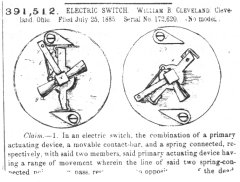
Not shown in the photo is a wooden ceiling button (for lamp drop cord)
complete with a round wooden cover which screws on. It is also a fused variety.
This item is marked "Pat. 9-13-87", but I didn't have that date when I
looked up these patents and cannot list the number here.
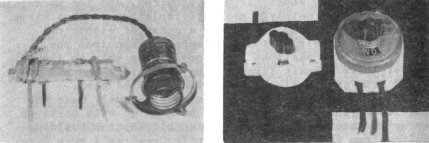
In the photo at left just above is still another type of wooden cleat with
original wire (segments), square nails and a super antique socket - once again,
quite a museum piece itself. The shade holder on it is marked with two patent
dates: One is 12-9-90 which turns out to be patent #442,410, and the other in
9-29-96 which is Design Patent #26,105.
You can well imagine the prevalence of house fires then with mickey mouse
wiring like this right against the wooden parts of the building.
The right-hand photo above shows two very early G.E. porcelain switches Fred
found in the same building. The one with the metal top cover has a patent date
of 5-30-05, but there are several G.E. patents of that date which could pertain
to this switch style.
Considering the immensity of the electrical industry history since Edison
invented the incandescent lamp bulb in 1881 and first supplied power for their
use in 1889, I feel that these very first wooden wiring insulators are priceless
museum pieces. It is fortunate that these several specimens survived the passage
of time.
Most electrical wiring before the era of porcelain wiring insulators (early
1890's) would have been in portions of cities which would have long since been
razed for more modern structures. But, just as Fred found out, there just may be
some very old buildings wired with these which have somehow managed to survive
in one piece for the past 85 years. I urge all collectors in areas which had
electrical power in the very early period to seek out these great antiquities.
Thanks again, Fred, for sharing with us news of your continuing stream of
in-valuable insulator finds in your area. Maybe I should move up to Ouray!
Jack
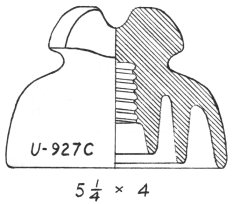
Dear Jack:
The enclosed Imperial insulator is one that I found last summer (1973) and
mentioned to you last winter.
Would you believe I had these for ten months and never noticed that some had
the spelling error "PORCELIAN" until your writeup. I'm sure Mike got
his error specimen from Ken or me. I have them both correct spelling and error
spelling, all with the 4-18-00 manufacturing date, so at least two handstamps
were in use simultaneously.
Lew Hohn (Rochester) also got one from me and wrote that he felt it was quite
different from any in the style chart so far. Mike, Lew and others have picked
up the "U-925 Sim" terminology from my advertising it that way in
November and April CJ ads. I'm wondering if you might feel it's deserving of a
new U- number after you've checked it over yourself since I last wrote to you
about it? It would certainly make it a lot easier to refer to in trade lists and
ads, especially in light of the marking error that exists on a few of these.
The wife and I will be attending the Fifth National at Hershey, our first
show of any type, and we are excited. Our families live in central Virginia,
about five hours from Hershey. I have already shipped five big boxes of goodies
out for the show and am packing more today.
Keep up the good work as I read and reread your column each month.
Bernard L.
Warren
1620 Stanton Court
Anchorage, Alaska 99504
- - - - - - - - - -
Dear Bernard:
Many thanks, and we have made good progress in getting all the Imperial and
other old styles drawn up in the past couple of years with the help of you and
others. This one is indeed different enough for a separate number, but the
"U-925 Sim" is a misnomer in that the U-925 is an eared type. This new
one is tentatively U-927C in the style chart, and it is most similar to the
U-927 as made by Thomas.
If the Hershey show is your first, you just won't believe it even when you
see it. It will really put you in orbit and will be something you'll never
forget. I have been to 3 nationals and dozens of smaller ones, but each one in a
new thrill. I think you may be a cinch to win the plaque for "furtherest
travelled".
Jack
| 